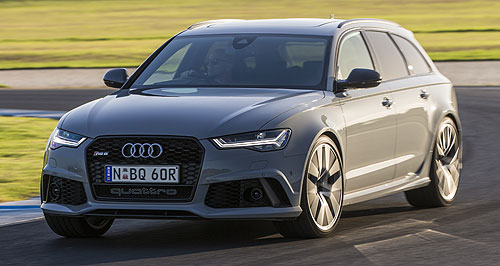New models - Audi - A6 - RS6 Avant PerformanceDriven: Audi's RS Performance pair blast inBrutal beauty: The RS6 Avant and RS7 Performance twins are the latest addition to the expanding Audi Sport stable. Audi’s RS6 and RS7 Performance editions arrived with spec and pricing boosts13 Apr 2016 THE Performance versions of Audi's already scorching hot RS6 Avant and RS7 Sportback have lobbed in Australia as the German car-maker continues the expansion of its Audi Sport stable. Adding the Performance badge to the go-fast RS6 Avant and RS7 Sportback corresponds with a hike in outputs, extra features and a trim upgrade to set them apart from the standard models being superseded. Both are now on sale but the extra gear and grunt comes at a cost, with the price of the RS6 Performance rising from the outgoing model’s $229,610 plus on-road costs figure to $245,400, while the RS7 Sportback Performance lifts from $241,610 to $258,000. The main foes for both models are sedan-only propositions, unless the bow is stretched a long way to include SUVs. The BMW M5 starts with its Pure model for $185,000 or the standard model is listed at $230,900. Both offer the twin-turbo 4.4-litre V8, in 412kW/680Nm Pure guise or 423kW/680Nm (which drops the sprint to 100km/h by 0.1 to 4.2 seconds) in the more expensive offering. Mercedes-AMG's 430kW/800Nm E63 S hits 100km/h in 4.1 seconds and is priced from $250,540. Audi Australia managing director Andrew Doyle described the outgoing models as being “extraordinarily successful” but said the new pair added an edge to the RS range. “Discerning customers at this very top end of the luxury sportscar market are always looking for an edge, and the new Audi Sport RS Performance models really offer a captivating combination of dynamic ability and individual design touches,” he said. The brand has started 2016 in solid style, with 6160 sales – up 12.4 per cent to the same point last year – and enough to put it in the top ten for Audi globally and ensuring Australia is one of Audi's fastest growing markets. Its Audi Sport models – including S, RS and R models – are also contributing in sales terms, now representing more than 16 per cent of the brand’s overall sales volumes, which grew by more than 20 per cent last year compared with 2014 sales, marking the 11th consecutive year of record growth in Australia. Audi describes the wagon and liftback models as being practical everyday supercars, with 565 litres of cargo space in the wagon (which makes up around two-thirds of sales), while the four-seater RS7 Sportback claims 535 litres – although the latter is aimed at the more design-conscious car buyer. The powerplant remains a 4.0-litre twin-turbo V8 with its turbos and exhaust within the engine’s ‘V’ it now produces 445kW (up from 412kW) with an unchanged offering of 700Nm of torque, although the new model boasts 750Nm on overboost for short periods. The overboost function gives the Performance pair a claimed 0-100km/h time of 3.7 seconds, an improvement of 0.2s. In just 12.1 seconds 200 km/h can be reached, 1.4 seconds quicker than the base RS models. Top speed is governed to 250km/h, although the options packages can increase that limit to 280km/h or 305 km/h with the Dynamic Package Plus that adds carbon ceramic brakes. Fuel consumption remains just in single digits despite the increase in power, with official figures of 9.6 litres per 100km for the Sportback (up 0.1L/100km) and 9.7L for the wagon, thanks to the engine’s cylinder-on-demand system. Dropping cylinders two, three, five and eight by way of closing the valves and halting the fuel injection achieves as much as 10 per cent better fuel consumption. The drivetrain retains the eight-speed automatic transmission and rear-biased ‘quattro’ all-wheel drive system, including the active torque-vectoring rear differential and the active sports exhaust. The Performance tag also brings titanium look to the vehicles’ exterior trim around the grille, bodykit, window surrounds as well as matte-finish 21-inch wheels. Standard on the Performance models are the clever matrix LED headlights, as well as dynamic indicators front and rear. The interior is upgraded with the addition of Alcantara and Valcona leather trim, the latter with contrasting blue honeycomb stitching and a carbon-fibre ‘blue twill’ inlay. The RS models also get the high-resolution Driver Information System (DIS) between the traditional dials for the speedometer and tachometer, able to display crystal-clear mapping or trip computer data that includes an overboost display. Other standard fare includes the RS adaptive air suspension, digital TV and radio reception, a head-up display (HUD), the Audi parking system plus with front and rear sensors, the 360 degree view camera system, a glass sunroof (panoramic only for RS6 Avant), the now-traditional RS leather-wrapped flat-bottom sport steering wheel and a powered opening and closing rear tailgate. As well as the eight front and side airbags, tyre pressure monitoring, stability and traction control, Audi has fitted a number of active safety systems on the RS range including the accident-prep Audi pre-sense plus, adaptive cruise control, automatic emergency braking, blind-spot warning and active lane assist. The options list has been pared down from the once-extensive list of choices — there’s a $4900 dynamic package which adds the variable-ratio dynamic steering, a 280km/h top speed and the Dynamic Ride Control (DRC) system, which replaces the air suspension with a more performance-focussed adaptive damper set-up to better control pitch and roll. The $8500 Carbon styling package provides distinctive visual intent on the vehicle’s exterior, with a number of design touches in the appealing raw carbon fibre finish. There’s also a $25,840 Dynamic Plus option package that ups the top speed limit to 305 km/h and adds larger carbon-fibre reinforced ceramic brakes to the features list, which boosts stopping power and takes about 10kg from the 1950kg (1930 for the RS7) kerb weight. 2016 Audi RS Performance pricing*
 Quick testsRead more17th of March 2016  Audi has hands up for more sporty variantsPopularity of RS3 and others means more Audi Sport models likelyAll new models Alfa Romeo Alfa Romeo Abarth Abarth Alpine Alpine Alpina Alpina Audi Audi Aston Martin Aston Martin BMW BMW Bentley Bentley Chery Chery Brabham Brabham Chrysler Chrysler Chevrolet Chevrolet Cupra Cupra Citroen Citroen DS DS Dodge Dodge Fiat Fiat Ferrari Ferrari Foton Foton Ford Ford Great Wall Great Wall FPV FPV Haval Haval GWM GWM Honda Honda Holden Holden Hyundai Hyundai HSV HSV Isuzu Isuzu Infiniti Infiniti Jeep Jeep Jaguar Jaguar Lamborghini Lamborghini Kia Kia LDV LDV Land Rover Land Rover Lotus Lotus Lexus Lexus Maserati Maserati Mahindra Mahindra McLaren McLaren Mazda Mazda Mercedes-Benz Mercedes-Benz Mercedes-AMG Mercedes-AMG Mini Mini MG MG Nissan Nissan Mitsubishi Mitsubishi Pagani Pagani Opel Opel Porsche Porsche Peugeot Peugeot Ram Ram Proton Proton Rolls-Royce Rolls-Royce Renault Renault Saab Saab Rover Rover Smart Smart Skoda Skoda Subaru Subaru SsangYong SsangYong Tesla Tesla Suzuki Suzuki Toyota Toyota Volvo VolvoA6 pricing
Motor industry news |
|
||||||







































Facebook Twitter Instagram